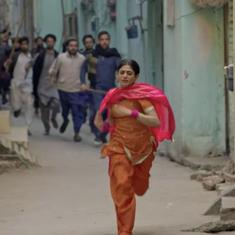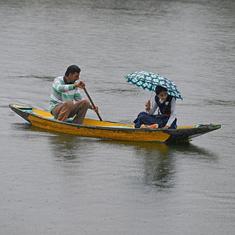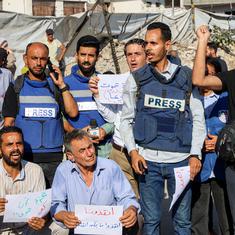From 15,000 feet, architect documents Mumbai's aerial geography (and pollution)
Robert Stephens' photos, taken from airplane window seats, come with quirky snippets about Mumbai's history and a visual commentary on its pollution levels.
“...Bombay was reported to be so densely crowded as to be almost uninhabitable except at inconvenient distances from the business-centre, and house-rent was consequently exorbitant even with most wretched accommodation.”
If you though this is a fairly recent description, think again: the congested city described above is actually the Bombay of 1850, a time when house rents were an “exorbitant” Rs 60 a month for a “miserable bungalow” with eight rooms.
The description from the 1909 Gazetteer of Bombay City and Island finds itself as a caption for this photo of central Mumbai, shot in March 2014.

‘Capital Missiles’. Photos: Robert Stephens
The photo is one of the 24 aerial photographs by architect Robert Stephens that have been on exhibition in Mumbai for the past week. The show, called Mumbai Articles, has pictures that Stephens shot from the window seats of planes when he took flights out of the city, using a simple point-and-shoot camera.
Shot over nearly six years from 2009 to 2014, the pictures are, for Stephens, a spontaneous exercise in documenting the contemporary geography of a port city that he has come to love.
“I am an architect, not a photographer, and I love looking at maps,” said Stephens, an American who moved to Mumbai in 2007 to work with the prominent architecture firm RMA Architects. “From the air, Bombay offers compelling, photogenic views that I felt I had to capture.”
More than just photos
Stephens’ aerial photos, taken 15,000 feet above sea level, are stunning in themselves, but his exhibition has more grounded perspectives to offer.
He chose to caption his photos with quirky historical excerpts from a host of books about Mumbai, from the 1909 Gazetteer and the 1914 Land Revenue Act, to a 1983 book on the Bombay Dockyard and even a 1973 guidebook for tourists.
“I had bought all these books from Flora Fountain and when I read them, I got the impression that some things in the city have changed completely, but many other things have remained the same,” said Stephens.
Pollution meter
The most unique feature of the photos is that they come with an index of the pollution levels in the city on the day that each picture was shot.
“When I first printed my photos, I couldn’t figure out why they were so grainy – some more than others,” said Stephens. “Then my wife pointed out that it could be because of Mumbai’s pollution.”
Sure enough, when Stephens looked up pollution levels in the city on the Maharashtra Pollution Control Board website, he found his answer: the higher the pollution on a given day, the grainer the picture.
Stephens took note of three hazardous pollutants in Mumbai: RSPM (respirable suspended particulate matter), which has a permissable limit of 100 micrograms per cubic metre (µg/m3); SO2 (sulphur dioxide), which has a permissable limit of 80 µg/m3; and NOx (nitrogen oxide), which also has a permissable limit of 80 µg/m3.
On most days, says Stephens, the presence of RSPM and NOx in Mumbai is well above these limits. He decided to weave these readings into the exhibition, as a reminder of the sordid reasons for photos that appear strikingly beautiful.
Here are some of Stephens’ aerial pictures of Mumbai.
Urban Kabir
SO2 – 20 µg/m3
NOx – 31 µg/m3
RSPM – 131 µg/m3

Caption from the Development Plan for Greater Bombay, 1964.
“The wide roads of Bombay are no more wide in comparison with the enormous traffic that they have to carry now...Private cars have increased by over 75%, and all registered cars, trucks and taxis more than 100 per cent, during the past 10 years.”
Mumbai Mist
SO2 – 10 µg/m3
NOx – 143 µg/m3
RSPM – 163 µg/m3

Caption, from Gazetteer of Bombay City and Island, 1909.
“From time to time whales have appeared in the neighbourhood of the island...In April 1906 a whale, 63 feet in length and apparently belonging to the Greenland species, drifted ashore at Bassein in the Thana District. Sea-snakes are common in Bombay waters, and prior to the building of the causeway, Colaba was famous for turtles.”
Nitrogen City
SO2 – 27 µg/m3
NOx – 267 µg/m3
RSPM – 131 µg/m3

Caption, from Gazetteer of Bombay City and Island, 1909.
“The island of Bombay should now no longer be considered a settlement of a separate colony but as the metropolis...of an extensive domain. For this island, only 20 miles in circumference and almost covered with houses and gardens, will soon become a city similar to the outer towns of Surat and Ahmedabad...”
Submerged Forests
SO2 – 18 µg/m3
NOx – 14 µg/m3
RSPM – 77 µg/m3

This photo depicts a part of the eastern docklands of Mumbai and the lengthy caption, from the 1909 Gazetteer, describes how an excavation of the dock in the late 1800s unearthed a whole forest embedded in layers of rock, clay and loam.
“Nearly 300 trees were found imbedded in the loam and rock. Many had been overturned before being covered by the clay deposit...while others were standing upright with their roots deeply planted in the soil.”
Marine Drive:
SO2 – 26 µg/m3
NOx – 53 µg/m3
RSPM – 223 µg/m3

The caption, from The Bombay Dockyard, 1983, explains how Colaba Causeway was built in the mid-1800s. Like the iconic Marine Drive, the Causeway was also born out of extensive reclamation.
“In the beginning of the 16th century Colaba was joined to the Island of Bombay by a ledge of rocks over which the sea water flowed. This channel was usually crossed in a ferry...In later times it became a pleasant residential quarter, but often at high tide...it became difficult to cross the channel. This inconvenience was at length overcome by the erection...of a solid and handsome vellard with a footpath protecting the level and elevated road.”
Twins and Antilla
SO2 – 18 µg/m3
NOx – 38 µg/m3
RSPM – 144 µg/m3

Caption, from the 1909 Gazetteer.
“A double bay lies below, intersected by the island city which, buried at its base in plantations of palm-trees, emerges midway into a distance, while the harmonious grandeur of the whole mass in enhanced by the parting rays of the sun shining full upon them.”
Mahalakshmi’s Shadows
SO2 – 18 µg/m3
NOx – 38 µg/m3
RSPM – 162 µg/m3

Caption, from Bombay Handbook (for tourists), 1973.
“Pani-Walla – Bombay, bursting at its seams, suffers from an ever increasing water shortage. To supplement dry taps in the more congested areas, the pani (water) walla collects water from the remaining natural wells and trundles it from door to door in large wooden barrels mounted on delicately balanced two-wheeled hand carts.”
Carter Road
SO2 – 18 µg/m3
NOx – 33 µg/m3
RSPM – 141 µg/m3

Caption, from One Hundred Years of Bombay, 1937.
“It was represented that on Sunday afternoons drunken men were seen “lying helpless in the streets, driving in public conveyances, shouting their songs and jests as they pass...”
Low Tide
SO2 – 22 µg/m3
NOx – 24 µg/m3
RSPM – 99 µg/m3

Caption, from Bombay Handbook (for tourists), 1973.
“Except for the Christmas season, dress in Bombay is usually casual...For evening wear long dresses and hostess gowns are “in” and the latest is always the greatest. Hats, gloves and stockings are seldom worn...Also nice to have with you are bathing suits and your favourite brands of toilet articles and cosmetics.”
Tardeo to Dadar
SO2 – 22 µg/m3
NOx – 47 µg/m3
RSPM – 163 µg/m3

Caption, from Bombay City Land Revenue Act, 1914.
“From 1841, for nearly a decade, a great contest was maintained between the Honourable Company and the owners of the Salt Batty lands in consequence of Government having resumed certain plots of ground near the Race-Course for the purpose of stacking hay, without paying any compensation to the occupants thereof...”









